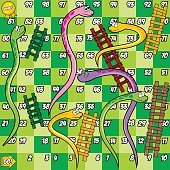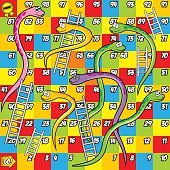SNAKE AND LADDER-MOKSHAPAT
The board game, Snakes and Ladders, originated in ancient India. At that time it was known as mokshapat. While no reference was made about the one who saw it, BC it is said that the game was already standing before the second century.
Some historians claim that it was discovered by the poet and saint Gnaniya Devi in the 13th century AD.
In ancient India, during the BC period, Hinduism believed the excellence of Karma and the sense of man's awareness of the resulting experiences that resulted in this exercise.
Mokshapat, popular in India at that time, was more common than snakes in snakes. Images of snakes and snakes were painted in the shape of a plaque in 124 square footers and pass through some of the squares. The edges were regarded as the result of the beginning of the square and the title of the snake head. And the guy is the traveler seeking salvation. The first square refers to hellfire as well as the postmodern belief of the ultimate goal of a human being, according to the last 124th Rectangle.
In the British era, in 1892, the English version of this sport was widely culminated in the British belief that Vatican values were largely ignorant of the faith and values of India. Inscribed images of the gods and angels in the boxes at the top of the board. In other boxes gave pictures of flowers, animals and pictures. The emphasis on thrift, penitence, and effort was the representation of lust, anger, and murders (murder). The number of snakes and snakes is equally westernized as snake and ladder.
The domination of their colonies in the Second World War began to end. In 1940, some of the paintings in the Bharatiya style were discovered and discovered that the snake and ladder were part of Bharatya Heritage Mokshapath.
In 1943, Milton Bradley founded the American business chits and ladder in the United States.
Below is a painting by an artist in Maharashtra in the 1800s. She is kept in the Royal Asiatic Society in London.
